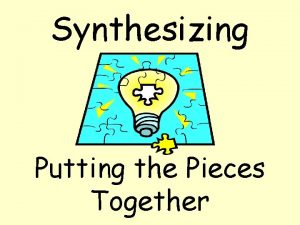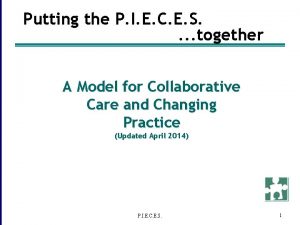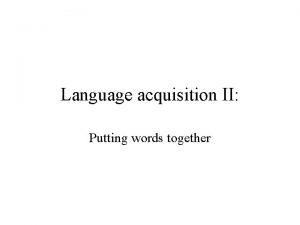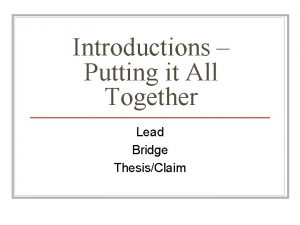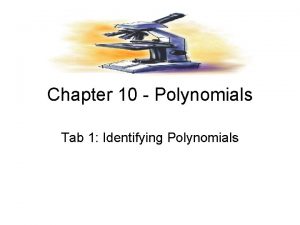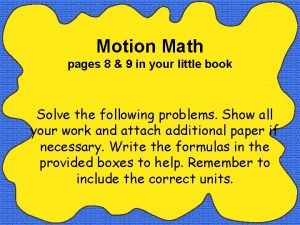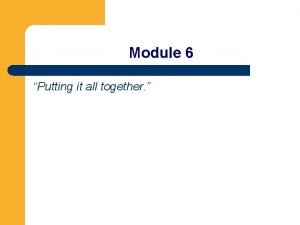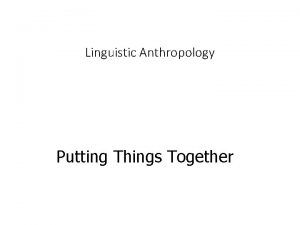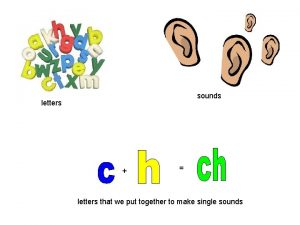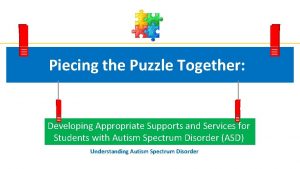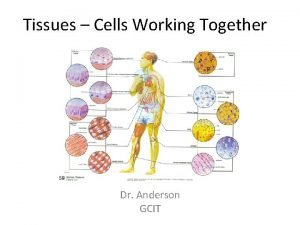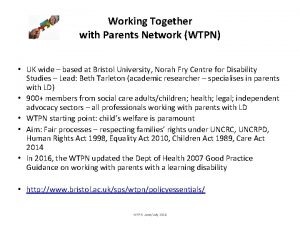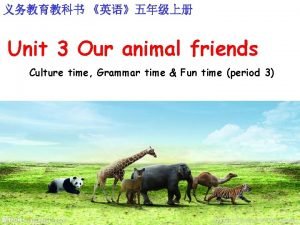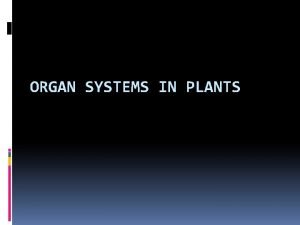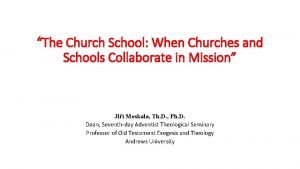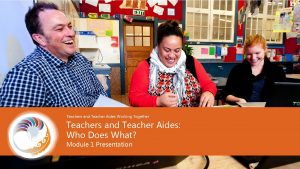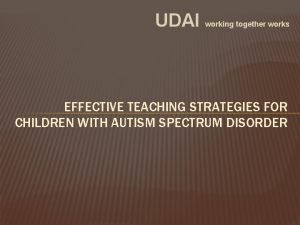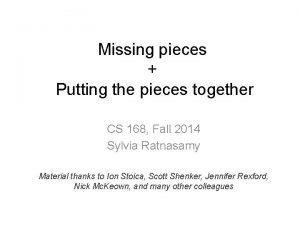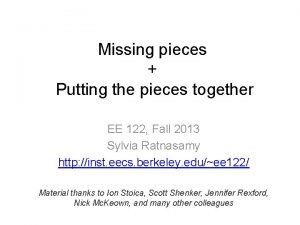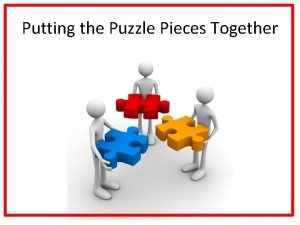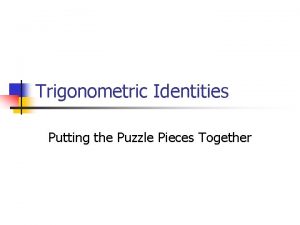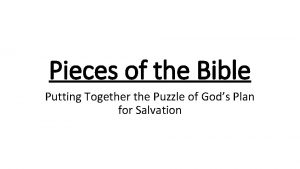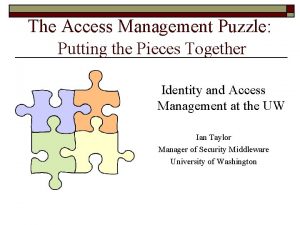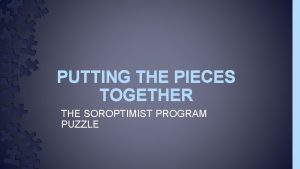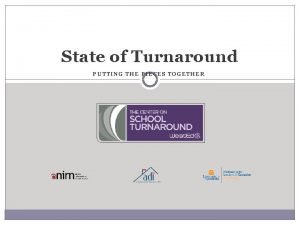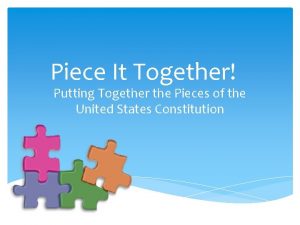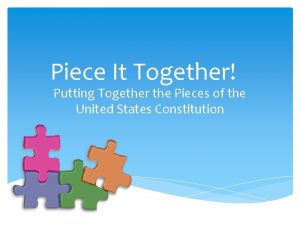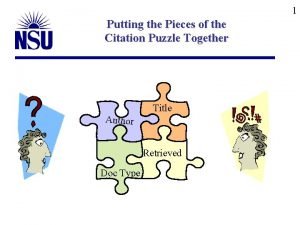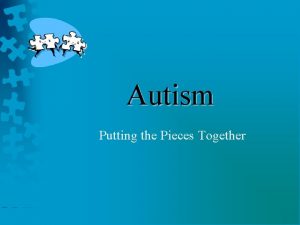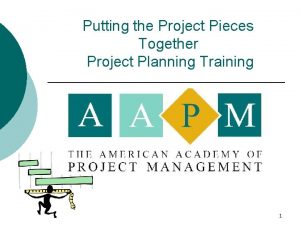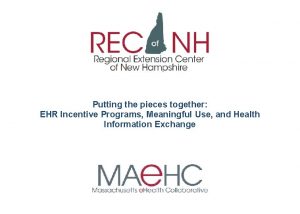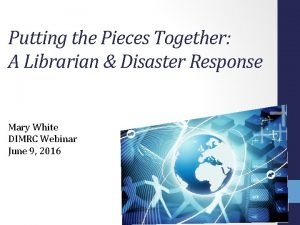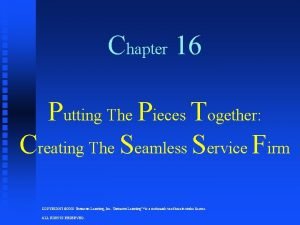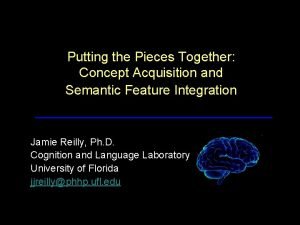Putting the Pieces of the Puzzle Together Working






























- Slides: 30

Putting the Pieces of the Puzzle Together: Working As a Cross-Disciplinary Team In Conducting Early Childhood Assessments Laurie Ford, Ph. D. Dept. of Educational & Counselling Psych & Special Education University of British Columbia What Develops? Understanding Assessment in Early Childhood Education Conference UBC - May 13, 2004 laurie. ford@ubc. ca

Special Thanks…. . My graduate students at UBC & USC Especially Carla, Jillian, Kat, Lori, MB, Sarah, Terri, & Vanessa My colleagues at UBC & USC Especially Rich, Susan, Hillel & Connie Those who taught me about the assessment of young children Especially Bob, Nancy, Bill, & Deb The children, families, and professionals who have taught me……

What I Hope to Accomplish √ Overview Key Issues in Effective Service Delivery for Young Children √ Review Domains Critical to Examine in the Assessment & Intervention of Young Children √ Highlight Aspects to Consider When Conducting Developmentally Appropriate, Culturally Responsive Service Delivery to Young Children √ Discuss aspects of working together as a team in conducting assessments √ Review common cognitive assessment instruments

Early childhood assessment is a field in transition. Dominated from its inception by psychometric models and measurement strategies used with older children, it is only now beginning to forge a methodology that is unique to young children. Meisels & Atkins-Burnett, 2000

Goal of Early Childhood Assessment To acquire new information and understanding that will help facilitate the child’s development and ability to function well in the home and family environment……

We need to…. Understand Describing, when Assessing A Child’s Development

Effective Service Delivery for Young Children Multi-disciplinary Multi Inter-disciplinary Inter “Trans-disciplinary” Trans

Effective Assessment & Intervention with √ Multi-Domain Young Children √ √ √ Multi-Source Family-Centered Interdisciplinary Ecologically Valid Non-discriminatory Formative and Summative

Key Domains in the Service Delivery to Young Children Cognitive Health Sensory Language Social. Emotional Physical Adaptive Family Home Community

Key People Involved in the Assessment of Young Children OT/PT Psychologist Educator Social. Worker Nutritionist Nurse Audiologist Parent/ Caregiver Siblings Physician SLP Optometrist Extended Family

Approaches in the Assessment of Young Children Observation Interview Formal Procedures Informal Procedures

Working As Team √ Role Release Allowing one team member to take on a role that might normally be the responsibility of another √ Arena Assessment Simultaneous evaluation of the child by multiple professionals from different disciplines √ Case Manager/Team Facilitator Consider one point person and joint evaluation reports

Factors External to the Child Which Impact on School Readiness & Early Child Development • Family Income – Effects of poverty on children’s development • Other Family Resources – Parental time and stress • Community Resources – Family support programs, child care programs • Societal Decisions – Paid family leave in case of illness, reinbursement of child care costs (Doherty, 1997)

Preschool Teachers Kindergarten Teachers Peers Time Child Neighborhood Family Peers Child Neighborhood Family

An Ecological Perspective § Rimm-Kaufman and Pianta (2000) propose an ecologically informed approach to the study of school transitions § Ecological and Dynamic Model of Transition § Involves the combined influence of the child, direct, indirect, and dynamic effects of contexts on children’s transition to school and the bidirectional interactions that exist between the child and their social networks. § Central importance of this model is the emphasis on development of relationships over time

On the Assessment of Young Children The science of strange behavior of children in strange situations with strange adults for the briefest possible period of time Bronfenbrenner, 1977

Principles of Appropriate Assessment of Young Children (adapted from Greenspan & Meisels, 1996) • Assessment should be based on an integrated developmental model. • Assessment involves multiple sources of information and multiple components. • An assessment should follow an orderly sequence.

Principles of Appropriate Assessment of Young Children (adapted from Greenspan & Meisels, 1996) • The child’s relationship and interactions with their caregiver should be the cornerstone of the assessment. • An understanding of the sequence of typical development is an essential framework to interpreting differences.

Principles of Appropriate Assessment of Young Children (adapted from Greenspan & Meisels, 1996) • • An assessment should emphasize attention to the child’s developmental level and way of organizing experiences and functional capacity in multiple domains. The assessment should identify the child’s current competencies and strengths, as well as the competencies that will constitute developmental progression in a continuous growth model of human development.

Principles of Appropriate Assessment of Young Children (adapted from Greenspan & Meisels, 1996) • • • Assessment is a collaborative process. The process of assessment should always be viewed as the first step in a potential intervention. Reassessment of a child’s developmental status should occur in the context of day-to -day family or EI activities or both.

Continuum of Assessment & Intervention • Assessment and intervention are distinct processes, they exist on a continuum. • The goal of any good assessment should be to design effective intervention for the young child and their family.

Measuring Intelligence • More broadly we think of measuring cognitive abilities • Most tests provide an overall quotient or score – Every test calls it something different • The more meaningful information typically comes from examining the factor, component, or subtest scores

Common Cognitive Assessment Instruments • Intelligence Tests or Measures of Cognitive Abilities…. . – Wechsler Scales (WISC-IV; WPPSI-III; WAISIII) – Stanford-Binet Scales of Intelligence (SB 5) – Differential Ability Scales (DAS) – Woodcock-Johnson Tests of Cognitive Abilities (WJIII COG) – Kaufman Assessment Battery for Children-II (KABC-II)

Wechsler Scales • Generally the most widely used • Provides an overall score -- Full Scale IQ (FSIQ) • Start with Two Scale Breakdown – Verbal (VIQ) & Performance (PIQ) • Secondary Factors are Useful for Interpretation – Verbal Comprehension (VC), Perceptual Organization (PO); Freedom from Distractibility (FD); Processing Speed (PS)

The Wechsler Scales • WISC-IV (Wechsler, 2003) – Ages 6 to 16. 5 • WPPSI-III (Wechsler, 2001) – Ages 2 -7 • WAIS-III (Weschler, 1997) – Ages 16 through senior adult

Stanford-Binet Scales of Intelligence- Fifth Edition • No Bonus for Speed • Overall score is Full Scale IQ (FSIQ) • Two Primary Domains – Verbal IQ (VIQ) & Nonverbal IQ (NVIQ) • Additional Factors – – – Fluid Reasoning Knowledge Memory Visual Spatial Processing Quantitative Reasoning

All Five Factors Measured in Verbal and Nonverbal Domains FACTORS DOMAINS Nonverbal Fluid Reasoning Knowledge Quantitative Reasoning Visual-Spatial Processing Working Memory Verbal

Full Scale IQ Nonverbal IQ 5 Nonverbal Subtests Factor Indexes Verbal IQ 5 Verbal Subtests Fluid Reasoning Knowledge Quantitative Reasoning Visual-Spatial Processing Working Memory Fluid Reasoning

Differential Ability Scales • Overall Score is the General Cognitive Ability score (GCA) • Three Main Factors – Verbal Reasoning – Nonverbal Reasoning – Spatial Reasoning

Woodcock-Johnson Tests of Cognitive Abilities • Overall Score is called the General Intellectual Ability score (GIA) • Seven Broad Factors – – – – Fluid Reasoning (Gf) Comprehension-Knowledge (Gc) Long-Term Retrieval (Glr) Visual-Spatial (Gv) Auditory Processing (Ga) Short-Term Memory (Gsm) Processing Speed (Gs)
 After putting the pieces together, what do they look like?
After putting the pieces together, what do they look like? Putting the pieces together case study answer key
Putting the pieces together case study answer key Putting two words together
Putting two words together Package mypackage class first class body
Package mypackage class first class body Bridge introduction paragraph examples
Bridge introduction paragraph examples Strategic organization means putting a speech together
Strategic organization means putting a speech together 6x²y³÷xy²= _______.
6x²y³÷xy²= _______. Putting it all together motion answer key
Putting it all together motion answer key Practice putting it all together
Practice putting it all together Putting things together is called
Putting things together is called Putting letters together
Putting letters together Pangaea map puzzle
Pangaea map puzzle Piecing the puzzle together
Piecing the puzzle together Hot working and cold working difference
Hot working and cold working difference Cold working and hot working
Cold working and hot working Machining operations
Machining operations Pengerjaan panas
Pengerjaan panas Hard work vs smart work
Hard work vs smart work Tissues are groups of similar cells working together to:
Tissues are groups of similar cells working together to: Tissues working together
Tissues working together Working together with parents network
Working together with parents network Teamwork animals working together
Teamwork animals working together Working together rafael and salvador
Working together rafael and salvador Working better together
Working better together Tissues are groups of similar cells working together to
Tissues are groups of similar cells working together to A group of organs working together
A group of organs working together Churches and schools working together
Churches and schools working together Teamwork
Teamwork Teachers and teacher aides working together
Teachers and teacher aides working together Udai working together works
Udai working together works Working better together
Working better together
